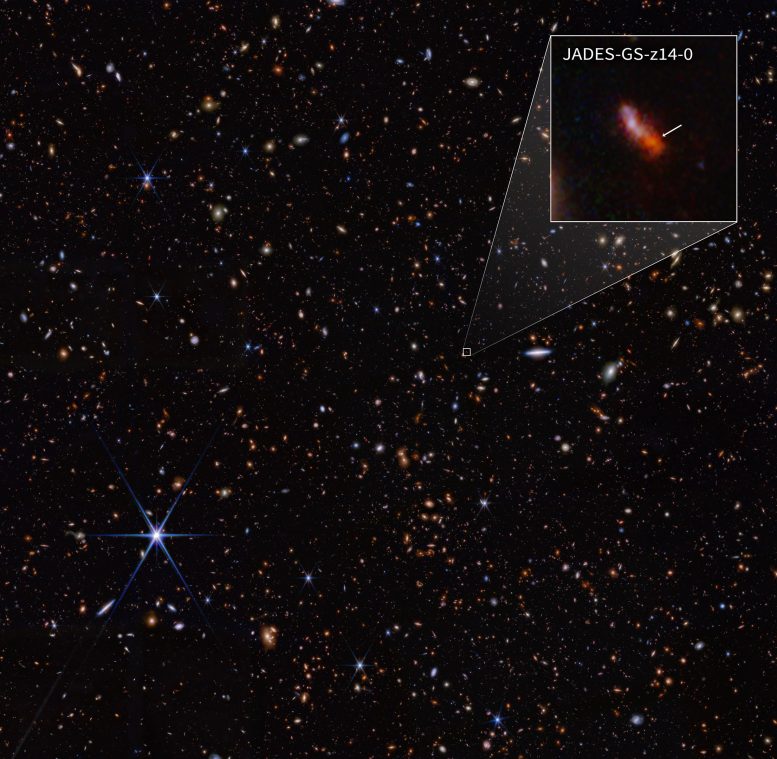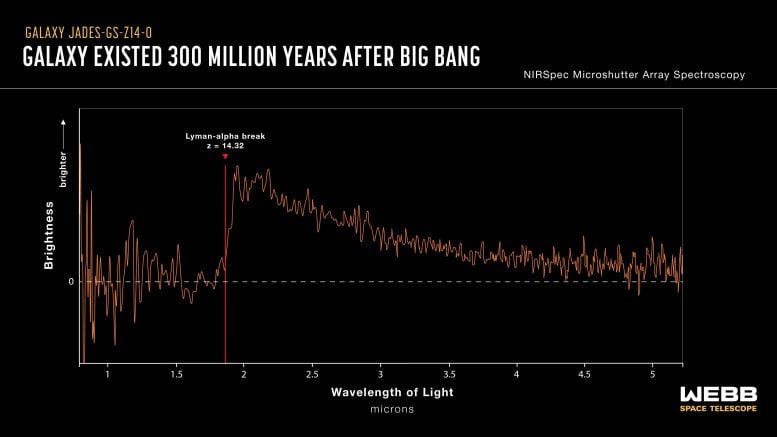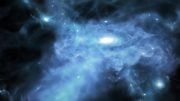
This infrared image from NASA’s James Webb Space Telescope (also called Webb or JWST) was taken by the NIRCam (Near-Infrared Camera) for the JWST Advanced Deep Extragalactic Survey, or JADES, program. The NIRCam data was used to determine which galaxies to study further with spectroscopic observations. One such galaxy, JADES-GS-z14-0 (shown in the pullout), was determined to be at a redshift of 14.32 (+0.08/-0.20), making it the current record-holder for the most distant known galaxy. This corresponds to a time less than 300 million years after the Big Bang. Credit: NASA, ESA, CSA, STScI, Brant Robertson (UC Santa Cruz), Ben Johnson (CfA), Sandro Tacchella (Cambridge), Phill Cargile (CfA)
NASA’s James Webb Telescope discovers a distant galaxy at redshift 14.32, suggesting unexpectedly rapid galaxy formation just 290 million years after the Big Bang.
Over the past two years, scientists have used NASA’s James Webb Space Telescope (also called Webb or JWST) to explore what astronomers refer to as Cosmic Dawn – the period in the first few hundred million years after the Big Bang where the first galaxies were born. These galaxies provide vital insight into the ways in which the gas, stars, and black holes were changing when the universe was very young.
In October 2023 and January 2024, an international team of astronomers used Webb to observe galaxies as part of the JWST Advanced Deep Extragalactic Survey (JADES) program. Using Webb’s NIRSpec (Near-Infrared Spectrograph), they obtained a spectrum of a record-breaking galaxy observed only two hundred and ninety million years after the Big Bang. This corresponds to a redshift of about 14, which is a measure of how much a galaxy’s light is stretched by the expansion of the universe.
We invited Stefano Carniani from Scuola Normale Superiore in Pisa, Italy, and Kevin Hainline from the University of Arizona in Tucson, Arizona, to tell us more about how this source was found and what its unique properties tell us about galaxy formation.

Scientists used NASA’s James Webb Space Telescope’s NIRSpec (Near-Infrared Spectrograph) to obtain a spectrum of the distant galaxy JADES-GS-z14-0 in order to accurately measure its redshift and therefore determine its age. The redshift can be determined from the location of a critical wavelength known as the Lyman-alpha break. This galaxy dates back to less than 300 million years after the Big Bang. Credit: NASA, ESA, CSA, Joseph Olmsted (STScI), S. Carniani (Scuola Normale Superiore), JADES Collaboration
Breakthrough in High-Redshift Galaxy Research
“The instruments on Webb were designed to find and understand the earliest galaxies, and in the first year of observations as part of the JWST Advanced Deep Extragalactic Survey (JADES), we found many hundreds of candidate galaxies from the first 650 million years after the big bang. In early 2023, we discovered a galaxy in our data that had strong evidence of being above a redshift of 14, which was very exciting, but there were some properties of the source that made us wary.
“The source was surprisingly bright, which we wouldn’t expect for such a distant galaxy, and it was very close to another galaxy such that the two appeared to be part of one larger object. When we observed the source again in October 2023 as part of the JADES Origins Field, new imaging data obtained with Webb’s narrower NIRCam (Near-Infrared Camera) filters pointed even more toward the high-redshift hypothesis. We knew we needed a spectrum, as whatever we would learn would be of immense scientific importance, either as a new milestone in Webb’s investigation of the early universe or as a confounding oddball of a middle-aged galaxy.
“In January 2024, NIRSpec observed this galaxy, JADES-GS-z14-0, for almost ten hours, and when the spectrum was first processed, there was unambiguous evidence that the galaxy was indeed at a redshift of 14.32, shattering the previous most-distant galaxy record (z = 13.2 of JADES-GS-z13-0). Seeing this spectrum was incredibly exciting for the whole team, given the mystery surrounding the source.
“This discovery was not just a new distance record for our team; the most important aspect of JADES-GS-z14-0 was that at this distance, we know that this galaxy must be intrinsically very luminous. From the images, the source is found to be over 1,600-light years across, proving that the light we see is coming mostly from young stars and not from emission near a growing supermassive black hole. This much starlight implies that the galaxy is several hundreds of millions of times the mass of the Sun! This raises the question: How can nature make such a bright, massive, and large galaxy in less than 300 million years?
Unveiling New Insights From Ancient Light
“The data reveal other important aspects of this astonishing galaxy. We see that the color of the galaxy is not as blue as it could be, indicating that some of the light is reddened by dust, even at these very early times. JADES researcher Jake Helton of Steward Observatory and the University of Arizona also identified that JADES-GS-z14-0 was detected at longer wavelengths with Webb’s MIRI (Mid-Infrared Instrument), a remarkable achievement considering its distance. The MIRI observation covers wavelengths of light that were emitted in the visible-light range, which are redshifted out of reach for Webb’s near-infrared instruments.
“Jake’s analysis indicates that the brightness of the source implied by the MIRI observation is above what would be extrapolated from the measurements by the other Webb instruments, indicating the presence of strong ionized gas emission in the galaxy in the form of bright emission lines from hydrogen and oxygen. The presence of oxygen so early in the life of this galaxy is a surprise and suggests that multiple generations of very massive stars had already lived their lives before we observed the galaxy.
“All of these observations, together, tell us that JADES-GS-z14-0 is not like the types of galaxies that have been predicted by theoretical models and computer simulations to exist in the very early universe. Given the observed brightness of the source, we can forecast how it might grow over cosmic time, and so far we have not found any suitable analogs from the hundreds of other galaxies we’ve observed at high redshift in our survey.
“Given the relatively small region of the sky that we searched to find JADES-GS-z14-0, its discovery has profound implications for the predicted number of bright galaxies we see in the early universe, as discussed in another concurrent JADES study. It is likely that astronomers will find many such luminous galaxies, possibly at even earlier times, over the next decade with Webb. We’re thrilled to see the extraordinary diversity of galaxies that existed at Cosmic Dawn!”
For more on this discovery, see Webb Uncovers Most Distant Known Galaxy.
Reference: “Earliest Galaxies in the JADES Origins Field: Luminosity Function and Cosmic Star-Formation Rate Density 300 Myr after the Big Bang” by Brant Robertson, Benjamin D. Johnson, Sandro Tacchella, Daniel J. Eisenstein, Kevin Hainline, Santiago Arribas, William M. Baker, Andrew J. Bunker, Stefano Carniani, Courtney Carreira, Phillip A. Cargile, Stéphane Charlot, Jacopo Chevallard, Mirko Curti, Emma Curtis-Lake, Francesco D’Eugenio, Eiichi Egami, Ryan Hausen, Jakob M. Helton, Peter Jakobsen, Zhiyuan Ji, Gareth C. Jones, Roberto Maiolino, Michael V. Maseda, Erica Nelson, Pablo G. Pérez-González, Dávid Puskás, Marcia Rieke, Renske Smit, Fengwu Sun, Hannah Übler, Lily Whitler, Christina C. Williams, Christopher N. A. Willmer, Chris Willott, Joris Witstok, Accepted, Astrophysical Journal.
arXiv:2312.10033
These spectroscopic observations were taken as part of Guaranteed Time Observations (GTO) program 1287, and the MIRI ones as part of GTO program 1180.
Stefano Carniani is an assistant professor at Scuola Normale Superiore in Italy. He is also a member of the Webb/NIRSpec GTO team and studies galaxy and black hole evolution across cosmic time.
Kevin Hainline is an associate research professor at the Steward Observatory, University of Arizona. He is also a member of the Webb/NIRCam Science team, and is using data from the JADES GTO survey to explore the evolution of galaxies and active galactic nuclei at the highest redshifts.









Nice, but what if there are explanations for the red shift other than the galaxies “moving away from us”? If that red shift is uniform across the sky that would mean we’re at the center of it all and that doesn’t seem likely. And how can galaxies all radially escape the ground-zero of a “big bang” AND form complex clusters at the same time? The secular cosmology is just as fishy as the theological one.
Not too mention that we’re about to merge with the Andromeda galaxy in about 3 billion years. How’s THAT possible if we’re all running away from each other?